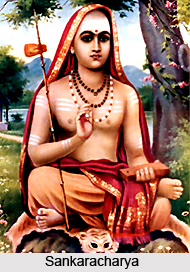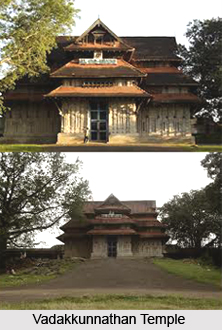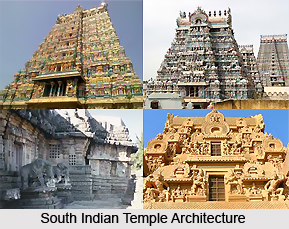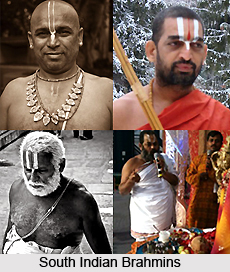 Religious influence in Kerala to a large extent has been influenced by the influx of Aryanisation in Kerala. It was mainly due to the Aryanisation of Kerala from the North which led to the foundation of many Hindu temples with a view to popularising Hinduism. This was followed by the Bhakti movement popularised by Hindu saints, which created a mental and religious stir among people culminating in Sankaracharya`s Advaita, in the 9th century.
Religious influence in Kerala to a large extent has been influenced by the influx of Aryanisation in Kerala. It was mainly due to the Aryanisation of Kerala from the North which led to the foundation of many Hindu temples with a view to popularising Hinduism. This was followed by the Bhakti movement popularised by Hindu saints, which created a mental and religious stir among people culminating in Sankaracharya`s Advaita, in the 9th century.
History says that long before the advent of Aryans, people of ancient Kerala followed Dravidian practices which were not based on any particular religious philosophy. They worshipped totem gods and innumerable spirits inhabiting rivers, trees, hills, etc. There were local deities guarding the borders of villages and demons that caused diseases. They propitiated them by offering food to the accompaniment of music and dancing.
While the people of Kerala were thus following Dravidian practices of worship, religions from the North, viz., Jainism, Buddhism and Brahminism entered Kerala in the centuries prior to the beginning of the Christian era. Though these religions gradually got converts among the people, the majority still continued to observe Dravidian practices. Each of these religions had deep impact on the people and the Dravidians were ultimately absorbed within the fold of Hinduism by the incoming Aryans by a process of assimilation and synthesis.
Jainism
The Jain religion came to Kerala in the 3rd century B. C. Jainism enjoyed high prestige in Kerala in the early centuries of the Christian era and had royal patrons as well. Jainism seems to have lingered till the 16th century and then it almost disappeared. The only vestiges of Jainism in Kerala today are the Jain shrines at Kallil, Mundur, Palghat and Sultan`s Battery. Besides some old Jain families live in the Wayanad and Kasargod area in north Kerala.
Buddhism
Buddhism also held sway in ancient Kerala during the reign of Ashoka in the 3rd century B. C. Buddhism was popular in coastal districts like Karumati, Mavelikkara, Bharanikkavu, Pallikkel, Karunagappalii, Idappalli, Dharmapattanam, Matayi and Pallikkunnu.
Many prominent Hindu temples of today like the Vadakkunnathan temple, Trichur, and the Kurumba Bhagawati temple, Kodungallur, and even the famous Ayyappa shrine atop Sabarimala are believed to have been at one time Buddhist shrines. The most important centre of Buddhist pilgrimage was Srimulavasam which is now under the sea.
 The Buddhist religion also began to decline from the 8th century and finally disappeared in the 12th century following vigorous propaganda by Hindu reformers like Shankaracharya. Both Jainism and Buddhism which could not be easily distinguished from each other even by the learned made very little appeal to the upper classes. Their strength lay among the comparatively backward classes. Even to them in course of time they tended to become less and less attractive.
The Buddhist religion also began to decline from the 8th century and finally disappeared in the 12th century following vigorous propaganda by Hindu reformers like Shankaracharya. Both Jainism and Buddhism which could not be easily distinguished from each other even by the learned made very little appeal to the upper classes. Their strength lay among the comparatively backward classes. Even to them in course of time they tended to become less and less attractive.
Buddhism and Jainism lost their appeal to the masses. Buddhism was absorbed in Hinduism in respect, of some of its ceremonies and forms of worship. The images, processions and utsavams, etc., associated with popular worship in present day Hindu temples in Kerala are said to be a legacy of Buddhism. Even the chakiyar kuttu conducted in temples is said to be an adaptation of the Buddhist monk`s religious exposition.
Growth of Shaivism and Vaishnavism
Cheraman Perumal Nayanar, one of the two Nayanars from Kerala, has been identified with Rajasekhara Varman (820-844 A.D.), the second of the kings who ruled over the Kulasekhara Empire. He spent his boyhood at the famous Shiva shrine at Tiruvanchikulam, near Kodungallur, worshipping the Lord. He went on pilgrimage to all important Shaivite shrines in South India in the company of his life-long friend and companion, Sundararnurthi Nayanar of Tiruvarur. The two saints are also believed to have breathed their last at Tiruvanchikulam where their images may still be seen in the Shiva temple.
Viralminda Nayanar was born at Chengannur. He was a Vellala, and as such a sudra by caste. He was a contemporary of Cheraman Perumal Nayanar, and a close associate of Sundaramurthi Nayanar. In his old age he left his native place for Chidambaram. He held the devotees of Lord Shiva as being more worthy than Shiva himself. He once compelled Sundaramurthi who was rushing towards the sanctum to show proper respect to the Sivanatiyar Tirukkuttam, saying that wherever the Atiyar devotees were assembled there Shiva also was present.
The work of the Nayanars and Alwars led to the establishment of several Shaiva and Vaishnava shrines all over Kerala. The Tiruvanchikulam temple associated with Cheraman Perumal and Sundaramurthi, and Trivandrum and other Vaishnava shrines praised by Alwars attracted numerous pilgrims from other parts of India.
Goddess Kali or Goddess Durga, neglected by the Nayanars and the Alwars, began to be worshipped as Sakti in the Tantras, which claimed to lead the votary to salvation by a shortcut. In course of time the Tantric mode of worship was adopted by some of the devotees of Lord Shiva and Lord Vishnu, who called themselves Shaivas and Vaishnavas respectively.
However, gradually all these religious sects began to succumb to fanaticism. The followers of Shiva and Vishnu began to quarrel for precedence and superiority. The Tantric worship became midnight orgy with women and liquor. Some of the sects took to murder and cannibalism. During the Kannaki festival a goldsmith was even publicly slaughtered at Tiruvottiyur.
 Advent of Shankaracharya
Advent of Shankaracharya
When religion was thus becoming tainted with vice and crime Shankaracharya (788-820), the great Advaita philosopher was born at Kaladi, an obscure village in central Kerala. He could not bear the sight of people quarrelling in the name of God and indulging in immorality and bloodshed to propitiate Him. Declining the gold and position offered by King Rajasekhara of Kodungallur, this Nambudiri Brahmin left Kerala in his youth and undertook a pilgrimage of all important centres of Hinduism in the country.
He propounded the philosophy of Advaita or One without a second and convinced the learned everywhere, who acknowledged the superiority of this system based on the teachings of the Upanishads and the Bhagavad Gita. According to this philosophy there is nothing real in this world except the One Supreme God, i.e. the Brahman.
Shankara borrowed some of the popular features of Buddhist faith and reformed Hindu religion on new and attractive lines. He converted his rivals not by miracles and ordeals, as Appar and Sambandhar did, but through argument. In fact, Shankara may claim to have carried the Buddha`s reasoning to its logical conclusion. He also accepted the Buddhist ideal of monasticism and set up a strong Brahminical institution by establishing maths in different corners of India in an effort to consolidate the moral and spiritual values and traditions of Hindusim. Sankara`s Advaita reconciled popular Hinduism with the philosophy of the Upanishads.
Impact of Aryanisation
Aryanisation of Kerala had also begun in the 3rd century B.C. following the advent, of Jains and Buddhists. It was a slow but steady progress resulting in far reaching changes in all spheres of human activity. The Aryan immigrants who were generally Brahmins and who stabilized themselves as the Nambudiris of Kerala were of two types. There were those who had taken up small trades and practically settled down in Kerala. Then there were small groups of the priestly class who began to enter Kerala in increasing numbers from the fifth century onwards. They succeeded in persuading the royalty to conduct ritual sacrifices for longevity and victory in war. They thus won the moral support and allegiance of the rulers. They also made them believe that protection of the Brahmins was an act of virtue on their part.
The increased influx of Aryans had its impact on the religious and culture at a time when Jainism and Buddhism had started declining. The new Aryan missionaries devoted all their attention to propaganda against Jainism and Buddhism whose hold on the people was a stumbling block to their ideological pursuits. They even resorted to iconoclasm of Buddhist images and Viharas.
 At the same time the Nambudiris filled the land with Hindu temples which by their fixed times of worship enforced a wholesome discipline in the daily life of the people. In fact it has been rightly said that "the temple as an institution was an Aryan gift to South India." Several temple arts and festivals wore instituted to attract devotees. The worship of Hindu gods and goddesses like Vishnu, Siva, etc., were made popular.
At the same time the Nambudiris filled the land with Hindu temples which by their fixed times of worship enforced a wholesome discipline in the daily life of the people. In fact it has been rightly said that "the temple as an institution was an Aryan gift to South India." Several temple arts and festivals wore instituted to attract devotees. The worship of Hindu gods and goddesses like Vishnu, Siva, etc., were made popular.
Dravidian deities were transformed and absorbed into the Hindu pantheon. Thus the Dravidian Goddess Kottavai became Durga, Kali and Bhagawati. The popular non-Aryan deity Sasta came to be looked upon as Hari-haraputra, the son of Vishnu (Hari) and Siva (Hara), in order to make Him acceptable not only to the Saivite and Vaishnavite sections of the Hindu population but also to the converts to Hinduism from within the Buddhist fold.
Thus the Hindu religion in Kerala was moulded by a synthesis of Aryan ideas from the North and Dravidian ideas from the South.



















